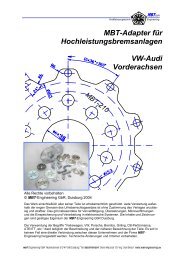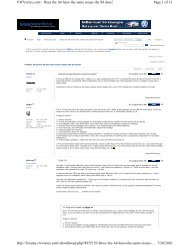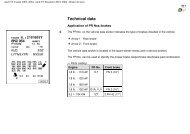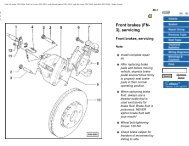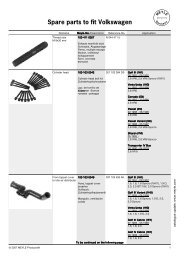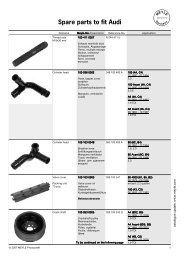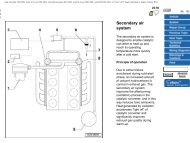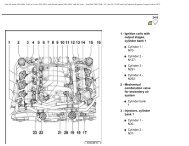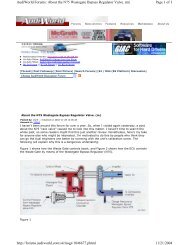VW MKII A2 MK2 Golf Jetta Fox Service Manual - VAGLinks.com
VW MKII A2 MK2 Golf Jetta Fox Service Manual - VAGLinks.com
VW MKII A2 MK2 Golf Jetta Fox Service Manual - VAGLinks.com
Create successful ePaper yourself
Turn your PDF publications into a flip-book with our unique Google optimized e-Paper software.
1 Radiator<br />
2 Fan ring<br />
3 Expansion tank<br />
4 Thermostat housing<br />
Air conditioning system<br />
The air conditioning unit works on exactly<br />
the same principle as a domestic refrigerator,<br />
having a <strong>com</strong>pressor, a condenser and an<br />
evaporator. The condenser is attached to the<br />
vehicle radiator system. The <strong>com</strong>pressor,<br />
belt-driven from the crankshaft pulley, is<br />
installed on a bracket on the engine. The<br />
evaporator is installed in a housing under the<br />
dashboard which takes the place of the<br />
normal fresh air housing. The housing also<br />
contains a normal heat exchanger unit for<br />
warming the inlet air. The evaporator has a<br />
blower motor to circulate cold air as required.<br />
The system is controlled by a unit on the<br />
dashboard similar to the normal heater control<br />
in appearance.<br />
The refrigerant used is a dangerous<br />
substance in unskilled hands. As a liquid it is<br />
very cold and if allowed to touch the skin will<br />
cause cold burns. As a gas it is colourless and<br />
Cooling, heating and air conditioning systems 3•3<br />
1.0b Cooling system <strong>com</strong>ponents - 1.05 and 1.3 litre, post August 1985<br />
5 Cover<br />
6 O-ring<br />
7 Thermostat<br />
8 Hose<br />
1.0c Cooling system <strong>com</strong>ponents – 1.6 and 1.8 litre, carburettor<br />
1081 <strong>VW</strong> <strong>Golf</strong> & <strong>Jetta</strong><br />
9 Automatic choke<br />
10 O-ring<br />
11 Coolant pump<br />
12 Inner timing cover<br />
13 Camshaft sprocket<br />
14 Timing belt<br />
15 Outer timing cover<br />
has no odour. Heavier than air, it displaces<br />
oxygen and can cause asphyxiation if pockets<br />
of it collect in pits or similar workplaces. It<br />
does not burn but even a lighted cigarette<br />
causes it to break down into constituent<br />
gases, some of which are poisonous to the<br />
extent of being fatal.<br />
Precautions<br />
Cooling system maintenance<br />
Do not remove the expansion tank filler cap<br />
or disturb any part of the cooling system<br />
whilst it is hot, as there is a very great risk of<br />
scalding. If the filler cap must be removed<br />
before the system is cool, then the pressure in<br />
the system must first be released. Cover the<br />
cap with a thick layer of cloth, to avoid<br />
scalding, and slowly unscrew the cap until a<br />
hissing sound can be heard. When the hissing<br />
has stopped, then system pressure is<br />
released. Slowly unscrew the cap until it can<br />
be removed. If more hissing sounds are<br />
heard, wait until they have stopped before<br />
unscrewing the cap <strong>com</strong>pletely. At all times<br />
keep well away from the filler opening.<br />
If the engine is hot, the electric cooling fan<br />
may start rotating even if the engine is not<br />
running. Be careful to keep hands, hair and<br />
loose clothing well clear of the fan when<br />
working in the engine <strong>com</strong>partment.<br />
Antifreeze mixture<br />
Antifreeze mixture is poisonous. Keep it out<br />
of reach of children and pets. Never leave<br />
antifreeze lying around, it is fatal if ingested.<br />
Do not allow antifreeze to <strong>com</strong>e in contact<br />
with your skin or the painted surfaces of the<br />
vehicle. Rinse off spills immediately with<br />
plenty of water.<br />
3



